Targeted protein degradation is an important technology that has been rapidly developed in the last decade to interfere with protein function. As a leading CRO, BOC Sciences is dedicated to expanding innovative degradation mechanisms and targets. Beside the most studied ubiquitination-proteasome system, we explore another important protein degradation system in eukaryotic cells, the lysosomal degradation system. LYTAC (lysosome-targeting chimera) is an degradation technology that utilizes lysosomes. We can offer LYTAC development service to provide new research tools for targeted drug discovery.
Introduction
Lysosomal degradation pathway has a wide range of applicability, including but not limited to proteins, protein multimers, organelles, etc. Lysosome-targeting chimera (LYTAC) is a protein degradation technology using endosomal-lysosomal system. Similar to the structure of PROTAC, LYTAC is a bifunctional molecule consisting of two binding ligands, one of which is an oligosaccharide structure targeting the lysosome-targeting receptors (LTRs) on the cell surface, and the other could be an antibody, peptide or small molecule targeting the protein of interest (POI), which are chemical conjugated by a linker.
Mechanism of action of LYTAC
First, the POI ligand of LYTAC binds to the extracellular domain of the POI, while the oligosaccharide structure binds to the LTRs on the cell surface, forming the LTRs-LYTAC-POI ternary complex; Sequentially, the complex enters the cell via clathrin mediated endocytosis (CME), and passes sequentially through the vesicles to the early endosome (EE) and late endosome (LE); With endosome acidification, the LTRs in the ternary complex dissociates and returns to the cell membrane or Golgi apparatus, and the binding of LYTAC and the target protein is continued to be transported to the lysosome for degradation.
 Fig 1. LYTACs degradation technology (Ahn, 2021)
Fig 1. LYTACs degradation technology (Ahn, 2021)
LYTAC Design
LYTAC is designed to be bound to POI at one end and recognized by LTR at the other end. Three choices of POI-binding ligands are available, including antibodies, peptides and small molecules. LTR-binding ligands include PolyM6Pn and Tri-GalNAc, which target the mannose-6-phosphate receptor (CI-M6PR) and the asialoglycoprotein receptor (ASGPR), members of the LTR family, respectively.
| LTR-binding ligands | POI-binding ligands | POIs |
|---|
PolyM6Pn 
Tri-GalNAc 
| Antibodies or their fragments | EGFR
ApoE4
CD71
PD-L1
HER2 |
Peptides- Polyspecific integrin-binding peptide (PIP)
| Integrins |
Small molecules- Dinitrophenol (α-DNP)
- MIF tautomerase inhibitor
| A model antibody binding DNP
Macrophage migratory inhibitory factor (MIF) |
Table 1. The design of LYTAC (Lin, 2021)
Our Services for LYTAC Technology Development
- Design and synthesis of complex LTR-binding ligands.
- Screening, design, synthesis or production of POI-binding ligands based on different targets.
- Screening of compounds with high affinity for target proteins from compound databases by virtual screening technique.
- Chemical modifications to improve the properties of drug molecules.
- Chemical and biochemical analysis services covering every stage of preclinical drug development.
Our Advantages
- Advanced LYTAC degradation technology
- Streamlined synthesis routes
- Quality one-stop service
- Short turn-around time and competitive price
- Data analysis, detailed report with results and discussion
- Highly reliable and reproducible result
- Experienced experts team and extensive expertise
Project Workflow

References
- Ahn, G., et al. LYTACs that engage theasialoglycoprotein receptor for targeted protein degradation, Nat. Chem. Biol., 2021, 17, 937-946.
- Lin, J., et al. Emerging protein degradation strategies: expanding the scope to extracellular and membrane proteins, Theranostics, 2021, 11(17): 8337-8349.

 Fig 1. LYTACs degradation technology (Ahn, 2021)
Fig 1. LYTACs degradation technology (Ahn, 2021)



